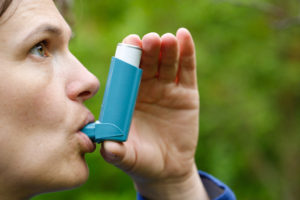 Asthma is a common life-threatening condition and its severity is often not recognised. It is a medical condition characterised by intermittent, reversible airway obstructions called asthma attacks.
Asthma is a common life-threatening condition and its severity is often not recognised. It is a medical condition characterised by intermittent, reversible airway obstructions called asthma attacks.
Asthma is a condition that affects the airway – the small tubes that carry air in and out of the lungs. When a person with asthma comes into contact with something that irritates their airways (an asthma trigger), the muscles around the walls of the airways tighten. This causes the tubes to become narrower and the lining of the airway becomes inflamed, causing swelling. Sometimes sticky mucus or phlegm builds up and can further narrow the airways. All of these reactions cause the airway to become irritated and narrower – making it difficult to breathe. Therefore leading to symptoms of asthma.
Asthma Facts
- Asthma is a common condition and it has varying levels of severity from mild to fatal.
- Around 2000 people die a year as a result of Asthma.
- 5.4 million people in the UK are currently receiving treatment.
- Of these, 1.1 million of these are children – which is 1 in every 11 children.
- There is a person with asthma in one in five households in the UK.
- Around £1 billion is spent on asthma treatment and care by the NHS every year.
Signs and Symptoms
A Moderate Asthma Attack would normally present the following symptoms:
- Breathing difficulties
- Coughing
- Wheezing
- Distress
- Anxiety
- Exhaustion
Where asthma is classified as severe, the patient will need professional help as they will need to be given a nebuliser and steroids. Life-threatening Asthma has the following signs and symptoms:
- Altered levels of consciousness
- Cyanosis (blue colour in the lips and extremities indicating a lack of oxygen)
- Hypotension (low blood pressure)
- Severe exhaustion
- Poor respiratory effort
- Peak flow of less than 33%
- Blood Oxygen levels of less than 92%
- A silent chest.
If you see any of these, call the Emergency Medical Services as soon as possible.
Medication
There are different medications for the treatment and management of Asthma. Sometimes, no matter how careful they are about taking their medicine and avoiding triggers, they may have an asthma attack. When someone has an asthma attack it can be very frightening for the patient and they may have their own way of dealing with the attack. Sometimes all you can really do is to get their inhaler for them and reassure them. If you interfere too much they may seem angry but they are fighting to breathe and the last thing they need is a first aider telling them what to do when they already know.
People with asthma usually carry two types of inhaler:
- Brown – a preventative usually taken daily. The medication is normally a steroid, commonly in the form of sodium cromoglicate or nedocromil.
- Blue
 – a reliever for when an attack is happening. The medication is called bronchodilators and is normally in the form of salbutamol (seen on the right) or terbutaline.
– a reliever for when an attack is happening. The medication is called bronchodilators and is normally in the form of salbutamol (seen on the right) or terbutaline.
When an Asthma Attack Occurs
If it is the first time someone is having what you think is an asthma attack, get them to a doctor or hospital as soon as possible as you will not have medications and therefore you cannot treat it. Some people may not have their inhalers on them, and there are certain things you can do if this is the case. The following guidelines are suitable for both children and adults and are the recommended steps to follow in an asthma attack.
As a first aider, you should encourage the patient to use the inhaler, you do not usually do it for them. Try and find a history of the patient in relation to the previous 6 to 48 hours prior to the attack. This information may be of help to the paramedics if things get worse.
- Find their reliever inhaler (usually blue), immediately after you recognize they are having an attack.
- Sit them down and ensure that any tight clothing is loosened. Do not lie down. In mild cases, they may prefer to stand to initially take their medication.
- If no immediate improvement during an attack, they should continue to take one puff of your reliever inhaler every minute for five minutes until symptoms improve.
- If their symptoms do not improve in five minutes – or you are in doubt – call 999 or a doctor urgently.
- They should continue to take one puff of their reliever inhaler every minute until help arrives.
After First Aid
If they are admitted to hospital or an accident and emergency department because of their asthma, make sure they take details of their medicines with them. This allows the doctors to know what has been prescribed and what has been taken. In most cases, the inhaler will deal with the attack and they will soon start feeling better. However, if you do not see signs of improvement or if they get worse, call the emergency medical services as soon as possible. Even if the patient says they do not want to make a fuss, it is better to be seen by a doctor to ensure they are ok and do not need further care.
If you were looking after someone’s child and they had an asthma attack while in your care, make sure you tell them. You will need to record any case of asthma that you treat in an accident book or in work records should one occur at work.
Have a look at our “Asthma Awareness” Course we offer throughout the U.K.
For more information on training courses, visit our “Courses” page which also includes our First Responder and First Person on Scene (FPOS) Courses.


Pingback: Peak Flow and measuring the volume and effectiveness of lungs